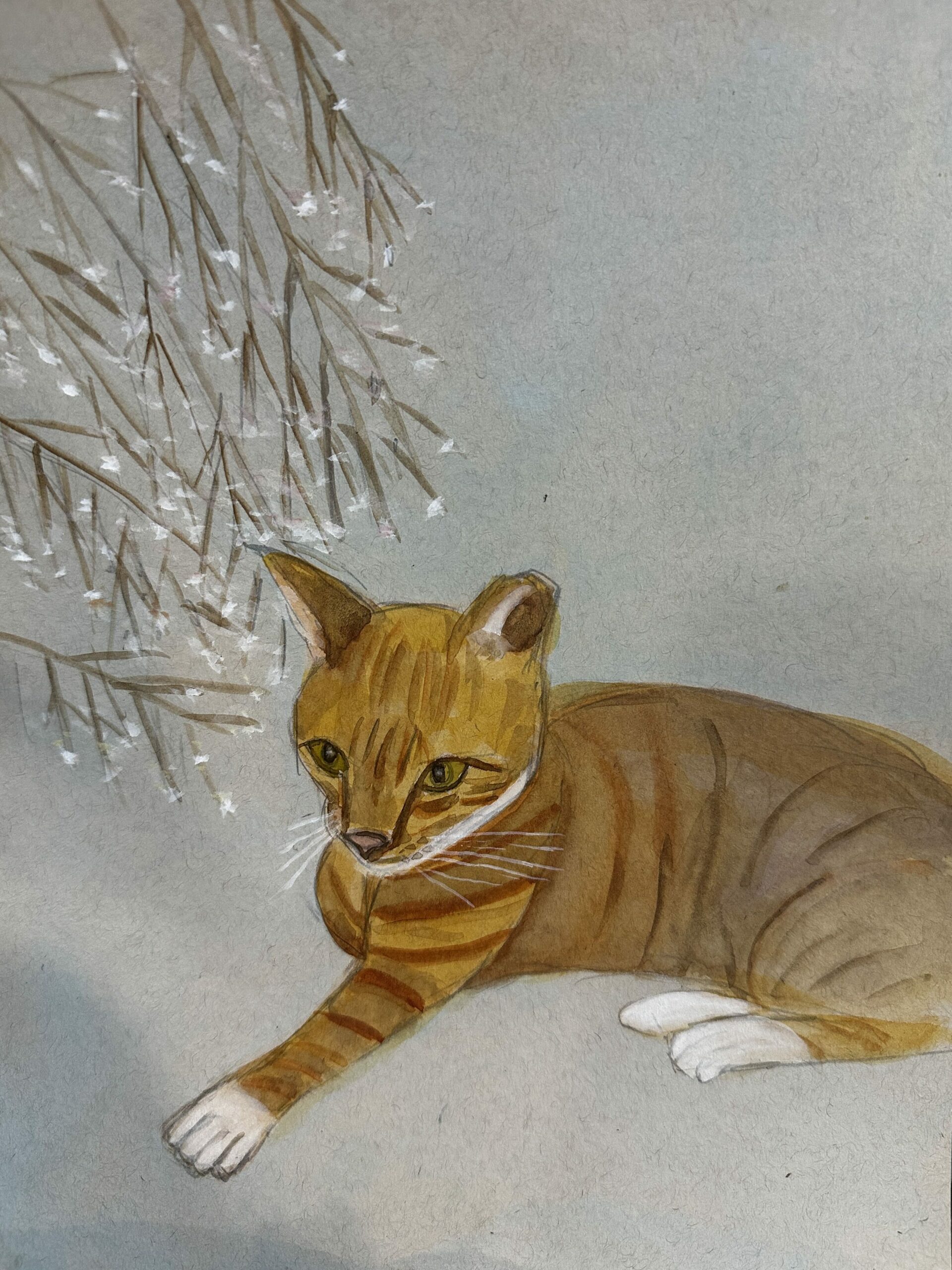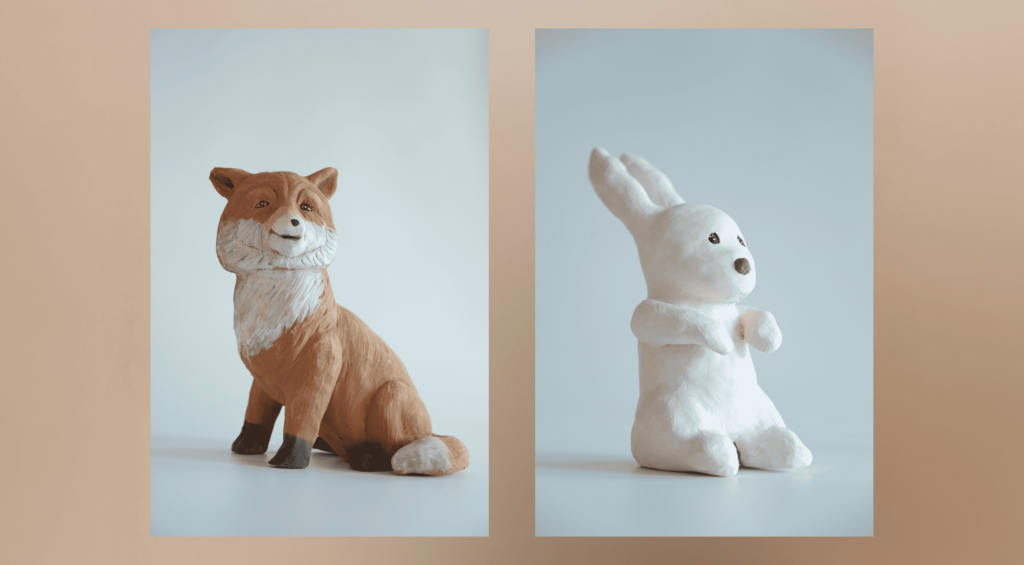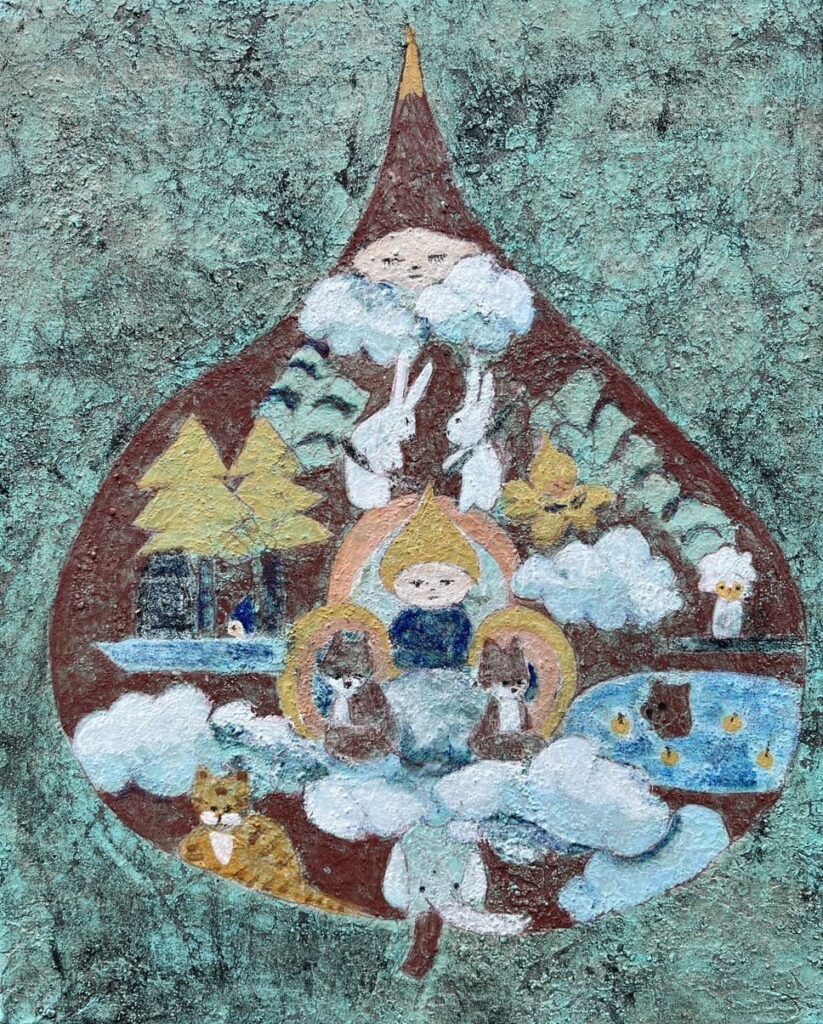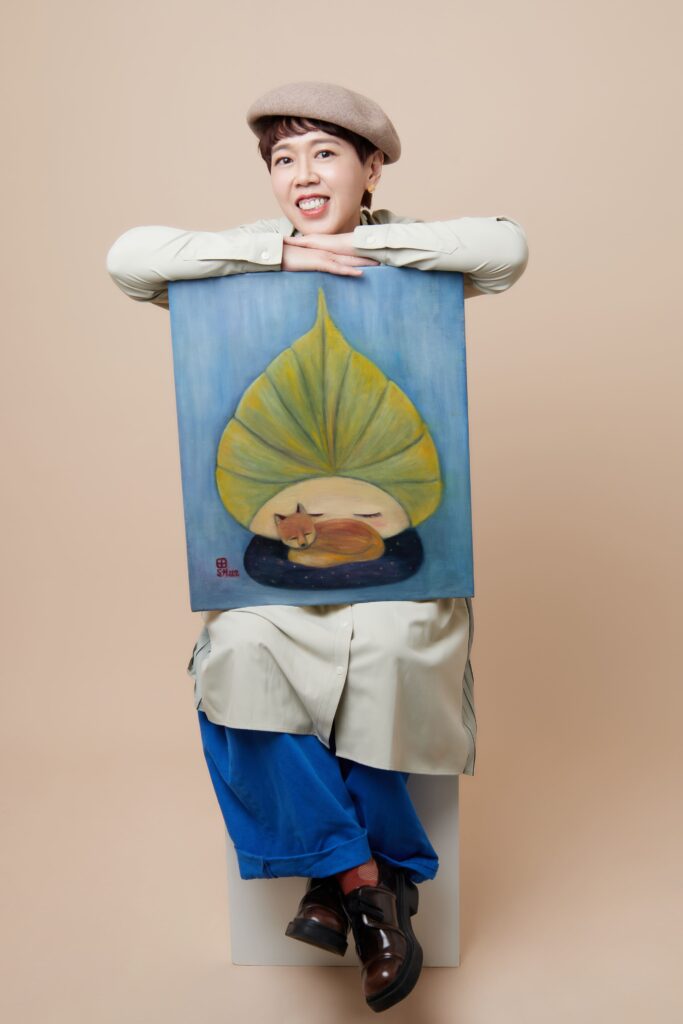In a world dominated by speed, efficiency, and instrumental rationality, the bond between humans and all living beings has grown increasingly distant. Animals, once revered as deities and messengers in human mythology, are now often confined to the margins of aesthetics, exhibition, and consumption, gradually losing their dignity and significance as living individuals. In such a context, can art still serve as a response? Can it help rebuild the broken connection between us and non-human lives?
In the work of artist Szuchi Huang, we find a possible echo. The foxes, rabbits, cats, and dogs she depicts are no longer mere fairy-tale companions or symbolic projections. They are real, soulful beings. With their postures, emotions, and presence, they quietly emerge in her paintings and sculptures, reminding us of the capacity for trust, gaze, and empathy, qualities we thought forgotten, yet remain deeply embedded in our inner language.
As an artist, Szuchi Huang is devoted not only to creation but also to education and companionship, constantly seeking a balance between art and life. Her works blend dreamscapes, stillness, and philosophical reflection, constructing a spiritual universe where humans and animals coexist. This artistic intent was candidly revealed during her interview with《The Icons》, where she emphasized that animals are not accessories to the human world, but equal life allies walking alongside us.
“I don’t paint animals just for the sake of painting them. I want them to finally be seen as themselves. They are not backgrounds, not symbols, not decoration. They are the protagonists.”
Seeing as Ethics: Letting Animals Return to Their Own Place
“I don’t see animals as symbols. I see them as lives. They are not here to complement human existence, but to be emotional, soulful beings in their own right.”
Throughout art history, animals have rarely been absent, but they have often appeared merely as symbols. The serpent as temptation, the lion as power, the lamb as purity or sacrifice. Yet for Szuchi Huang, such symbolic frameworks obscure the true value of animals as autonomous beings. She refuses to reduce them to metaphors or vessels for human emotion. Instead, she insists that they “stand in their own place,” appearing in the world as themselves. “I don’t want the animals in my paintings to play a role. I want them to simply live, to be themselves, freely and fully.”
Huang’s early training in visual and design disciplines sharpened her sensitivity to the act of seeing. She observes not only form, but the relationship between animals and their surroundings, how a stray cat chooses a patch of afternoon sunlight, or whether a fox’s gaze reveals wildness or wary observation. She avoids imposing postures, resisting the urge to compose for aesthetic effect. That kind of gaze, she says, is too human-centric. What moves her is the quiet spirit that emerges when animals are in their natural state. That is where true presence resides.
“I love seeing them as they are in daily life, not in cages, not posed. Only when they are at ease does their soul appear.” In her work, looking is not an act of control, but a form of ethical practice. Through art, she preserves their true being, not for our sentimentality, but for their own right to exist and be seen.

From Alleyways to Artworks: Reflections of Spirit and Self
“The rabbit is a projection of myself, but the fox is the spirit I aspire to.” In Szuchi Huang’s creations, animals are summoned from both life and inspiration. They may be a cat dozing in the sunlit corner of a street, a dog weaving through a crowd, or something entirely unnamable, like a fox from a dream or a beast from the depths of memory. She explains that these animals “aren’t characters I made up; they are presences I’ve felt,” as if they choose to appear on her canvas by their own will.
The rabbit was the origin of her artistic journey and an intuitive mirror of her personality. Huang describes the rabbit as gentle and quiet on the outside, seemingly mild-tempered, but possessing a fierce will and inner independence. “People often think rabbits are weak, but if you’ve raised one, you’d know how stubborn and strong-minded they truly are.” Her rabbits are not merely cute icons on the canvas. They are self-portraits of solitude and quiet resilience.
The fox, on the other hand, represents a spiritual totem she’s long revered. It belongs to no one, cannot be tamed, and constantly wanders the margins, an embodiment of freedom and instinct. “I’ve always felt the fox exists somewhere between human and divine,” she says. “It carries a kind of wisdom, perhaps even guidance.” While foxes in East Asian culture are often portrayed as mysterious or supernatural beings, in Huang’s work, the fox stands for spiritual elevation and the dignity of solitude.
These animals are never just decorative, anthropomorphized, or ornamental. They are sentient presences carrying profound meaning. With their distinct temperaments, rhythms, and stories, they act as mediators in her dialogue with the world and extensions of her artistic language. She repeatedly sketches their forms on canvas and in ceramic sculpture, as if meditating or summoning them, helping others relearn how to respect the quiet but perceptive souls among us.
“I don’t paint them because they’re cute,” she says. “I paint them because they know things we don’t. Animals can see what humans can’t, that’s the kind of spiritual vision I try to honour.”

Not Speaking for Them, But Letting Them Be Heard
Szuchi Huang never shies away from the relationship between her art and her convictions. For her, art is never merely self-expression. It is a statement of values and an ethical act. The quiet animals that inhabit her works are not there to decorate or please the eye. They represent a conscious gaze, a response to the overlooked, objectified, and commodified non-human lives. With each creation, she hopes to reclaim the right for these voiceless beings to be seen.
When discussing animal-related issues, she speaks with clarity and conviction. Whether it’s abandonment, experimentation, hunting, or consumer-driven pet ownership, she believes such wounds exist because humans fundamentally fail to see animals as individuals. We love their cuteness but overlook their pain and will; we say we care, yet harm them out of convenience and habit. “We always want to define them, control them, but animals don’t need to be explained. They just need the right to exist equally,” she says.
This is why she is especially mindful in her creative process, not to let animals become mere extensions of human stories, but to let them stand in their own right. She paints their gaze, sculpts their posture, and ensures that in her exhibitions, each animal becomes a protagonist in its own story, not a sidekick, not a pet, not a fairytale device, but a being unto itself.
Though she hasn’t yet collaborated on large-scale exhibitions with animal welfare organisations, it doesn’t mean she is silent. On the contrary, her art is her activism. In every drawing, every sculpture, each animal emerges with eyes, a name, and a soul, respected, understood, and recognised as a fellow inhabitant of this world.
“If humans stopped treating animals as accessories,” she says, “maybe the world would be a lot gentler. I hope art can be a reminder and a force.”

Responding to Sustainability Through Art: From Creative Practice to Empathetic Education
In the framework of the United Nations Sustainable Development Goals (SDGs), animal rights are not listed as a standalone category. However, their spirit runs through many of the targets, Good Health and Well-Being (SDG 3), Quality Education (SDG 4), Sustainable Cities and Communities (SDG 11), and Life on Land (SDG 15). For Szuchi Huang, these goals are not abstract international rhetoric, but deeply embedded in her everyday artistic reflections.
She firmly believes that art is not confined to galleries; it is a gentle form of activism capable of shifting perspectives and reshaping how we see the world. In her teaching, she encourages students to reconsider their relationships with animals, especially those without formal artistic training, whose personal experiences often foster a more authentic bond with non-human lives. “Art-making shouldn’t just be about technical skill. It should be a process of learning to see again,” she explains.
This way of “seeing” also informs her vision of education. She believes that through creating art with animals as the subject, we can rebuild our emotional connection with all living beings and inspire a rethinking of the concept of coexistence, not only in terms of environmental awareness but as a deeply rooted ethical stance. In her works, the fox is no longer a mystical symbol but a spiritual guide; the rabbit is not merely a symbol of cuteness but a quiet embodiment of inner strength. These animal figures gradually lead viewers to reconsider the meaning of equality, respect, and genuine understanding.
“SDGs speak of global goals,” Huang says, “but I believe they can begin with each act of creation, each character we bring to life. To help people see animals anew, is to help them see themselves anew.”

Szuchi Huang: Let Every Life Be Seen in the Light
Szuchi Huang never confines her work to canvases or gallery walls. For her, art is not merely about depiction or display. It is a force of action capable of entering society, challenging ways of seeing, and even repairing ethical relationships. In 2025, she held a solo exhibition titled Paradise, where foxes, rabbits, dogs, and cats were, for the first time, truly seen. They were not decorative backdrops or vessels of human emotion, but beings with personality, posture, and spirit, standing silently before every viewer.
The exhibition unfolded like a collective exercise in seeing, a prophecy for the soul: animals have never been mere supporting characters. It’s just that we have long stopped truly looking at them. Huang allowed each figure to emerge as a sovereign subject, with a name, a breath, and an undefinable aura. Viewers were no longer passive observers, but drawn into a deeper state of perception, where seeing became mutual and equal.
She envisions future exhibitions centered solely on the animals themselves, ones that resist function or anthropocentric symbolism, instead honouring the animal’s full presence. Not animals existing for humans, but beings living for themselves. For those souls often ignored, reduced, or consumed in everyday life, she seeks to rename them, retell their stories, and pave a gentle path back to the empathy humans are slowly losing.
This is not merely a question of artistic form. It is a restoration of the spirit, a reflection on broken relationships, and a quiet revolution in motion. Art may not change the world’s systems, but it can change the way we see the world. And that shift in perception is where true change begins:
“I’m not here to speak for the animals. I want them to finally be heard on their own. I want to build a space where each overlooked life can stand in its own light, not because it is cute, but because it has always been worthy.”

Recommend for you:
Art Beyond Borders: Artist Szuchi Huang on Creativity as a Journey to Self-Discovery